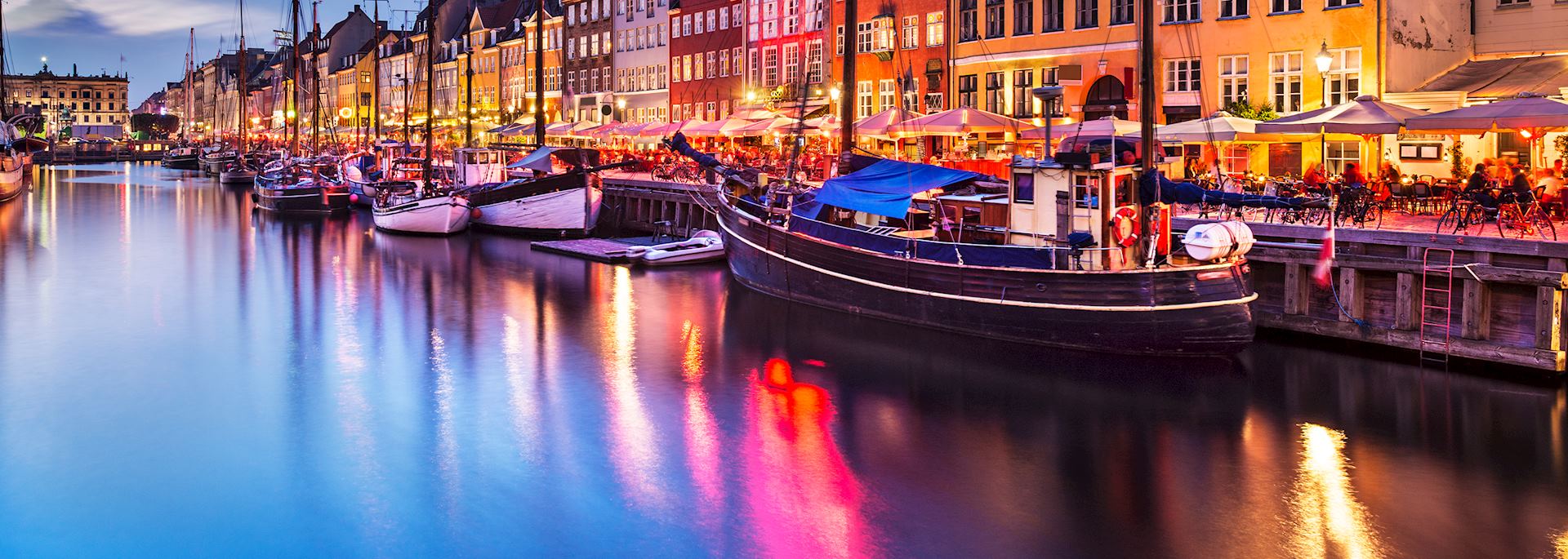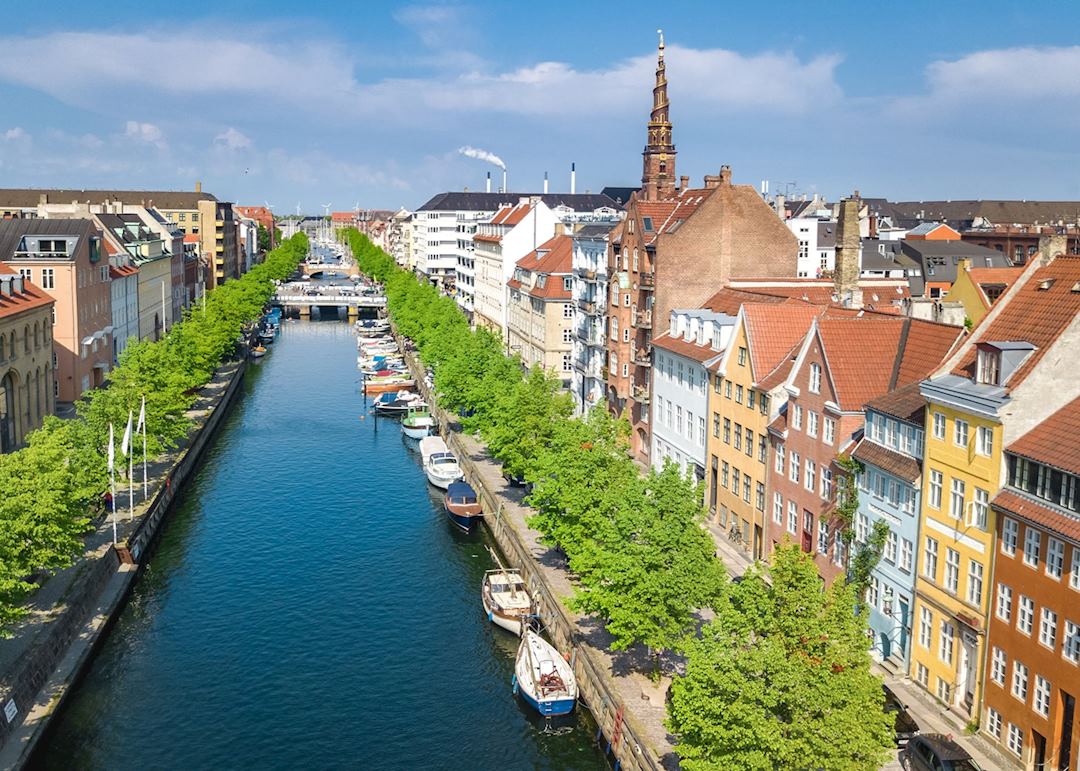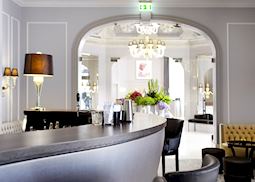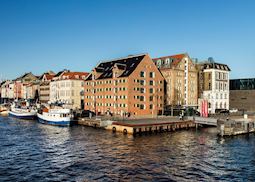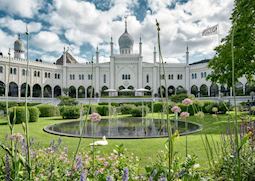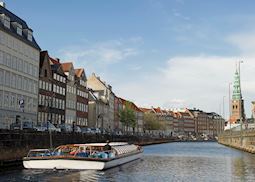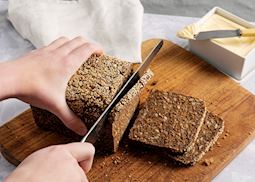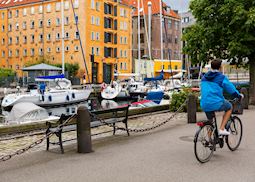Jump to:
Bicycle lanes, Bronze Age treasures, smorgasbord and three castles, plus a renowned mermaid, in Denmark’s stylish capital.
Denmark’s capital, Copenhagen is a compact and lively city that welcomes you with typically Danish aplomb. The city gracefully balances a wealth of history and tradition with cutting-edge design and modern approaches to sustainability. Whether you cruise the canals, cycle through the well-ordered streets or stroll along the pedestrian-friendly waterfront, it’s easy to get a sense of the city’s character.
We can help you explore more thoroughly with guided tours to the palaces and museums that dot the city. You might admire the Renaissance-era crown jewels at Rosenborg Castle, kayak through the canals or tour the waterfront and old town to admire the architecture. We can arrange for you to take a workshop on making Denmark’s signature dish, smørrebrød, or offer suggestions on when to best visit Tivoli Gardens, the oldest amusement park in Europe.
Things to see and do in Copenhagen
The Danish crown jewels at Rosenborg Castle
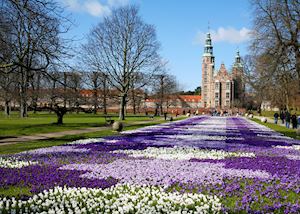 A fanciful confection of turrets and gables surrounded by lovingly tended gardens, Rosenborg Castle offers a portrait of Denmark’s Renaissance and the monarchs who ruled during the era. Built in the early 1600s as a summer palace by Christian IV, the palace’s two dozen upper rooms are arranged chronologically — each one dedicated to the reign of a different ruler.
A fanciful confection of turrets and gables surrounded by lovingly tended gardens, Rosenborg Castle offers a portrait of Denmark’s Renaissance and the monarchs who ruled during the era. Built in the early 1600s as a summer palace by Christian IV, the palace’s two dozen upper rooms are arranged chronologically — each one dedicated to the reign of a different ruler.
The grand finale is the room showcasing the crown jewels, a dazzling display of wealth and artistry, including Christian IV’s diamond-encrusted six-pointed crown. It’s easy to explore on your own or we can arrange for a privately guided tour of the castle and the city.
Christiansborg Palace and stables
A small island in the heart of the city, Slotsholmen has been the seat of political power in Denmark for almost a millennium. The palace that stands there today is an imposing granite building with copper accents that houses the country’s Prime Minister’s office, the parliament and the supreme court, as well as the Royal Receiving Rooms. It was built in the early 20th century, but in the basement, you can visit the ruins of Bishop Absalon’s 1167 castle.
The grounds also include the Kongelige Stalde and Kareter, a stable and carriage house where you can marvel at the elegant carriages the royal family has used since the 1700s. Riders in bright-red coats and black top hats exercise the horses daily. If you’d like to visit, we can include a guided tour of the palace with a walking tour of the city.
Exploring Nyhavn
Once a sailor’s quarter, Nyhavn today is a lively waterfront stretch with open-air cafĂ©s, street performers and brightly painted houses. The canal was built to connect Kongens Nytorv with the harbour, and you can easily while away an afternoon strolling down the promenade to take in the ever-changing array of wooden boats, the many buskers and the young people enjoying the sun with a beer. Take a seat at one of the fashionable cafĂ©s for an alfresco break to admire the never-ending parade.
Folklorist Hans Christian Andersen lived and worked here, writing some of his best-known works, including The Princess and the Pea, at no. 20.
A smorgasbord of smørrebrød
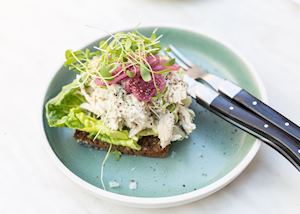 Denmark’s signature dish, smørrebrød, isn’t as well-known as its Swedish cousin with a similar name, but these open-faced sandwiches are a staple in the city and across the country. Literally translated to ‘butter bread’, they are dense slices of well-seeded rye piled high with a rainbow of toppings, including pickled herring, tiny briny shrimp and eye-watering horseradish cream. A traditional three-course meal starts with herring, then meat, and finishes with cheese, all washed down with bracing shots of aquavit.
Denmark’s signature dish, smørrebrød, isn’t as well-known as its Swedish cousin with a similar name, but these open-faced sandwiches are a staple in the city and across the country. Literally translated to ‘butter bread’, they are dense slices of well-seeded rye piled high with a rainbow of toppings, including pickled herring, tiny briny shrimp and eye-watering horseradish cream. A traditional three-course meal starts with herring, then meat, and finishes with cheese, all washed down with bracing shots of aquavit.
You can find smørrebrød everywhere from fine-dining restaurants to tiny storefronts. If you’d like to learn more about its history and how to make smørrebrød, we can arrange for you to take a workshop while you’re in the city.
Copenhagen’s pantry: TorvehallerneKBH
Copenhagen’s take on a traditional market is typically sleek and modern, spread out among two gleaming glass buildings as well as a section of open-air stalls. You can find everything from fresh fish and produce to kitchenware and even a cookbook shop. There are also plenty of restaurants and stands that offer prepared foods.
Glass cases conceal row upon row of smørrebrød pretty enough for a still life, as well as smoked meats, freshly baked bread, 88 types of local cheese and hand-brewed coffee. In addition to Danish food, you can also pause for tacos or a glass of wine, nibble on chocolate pastries and enjoy some of the city’s best pizza.
A cultural buffet of museums
As well as its various palaces, Copenhagen offers a wide array of museums you can visit. The National Museum examines the country’s history, from Viking drinking horns to modern-day Danish life. The National Gallery’s collection starts in the Middle Ages and continues to today. The Museum of Copenhagen concentrates more specifically on the city’s past, including an excellent exhibit on the life of philosopher and native son Søren Kirkegaard.
A 30-minute drive north of the city, the Louisiana Museum of Modern Art is a sprawling web of airy white rooms and glass hallways. Its ever-changing array of exhibits is only half the attraction. The lovely grounds face Øresund and include monumental modern sculptures nestled under leafy trees. If you’d like to visit, we can arrange for a guided tour.
Copenhagen’s best-known resident: The Little Mermaid
A sculptural ode to Hans Christian Andersen’s Little Mermaid, Den Lille Havfrue is arguably the city’s most popular resident. Slightly smaller than an actual mermaid might be, the bronze nude sits on a rock in the water just off the Langelinie promenade. She’s been attracting crowds since she was unveiled in 1913 — we recommend visiting early in the day to get the best view.
Stroll five minutes south along the waterfront to see the imposing Gefionspringvandet. This three-tiered fountain is presided over by an imposing image of the Norse goddess Gefjon driving a team of strapping oxen.
Tivoli Gardens, Europe’s oldest amusement park
Combining the best aspects of a Victorian exhibition, a botanical garden, a theme park and a beer garden, the gaily lit Tivoli Gardens has been an important destination in Copenhagen since it opened in 1843.
During the day, families flock here to enjoy games, snacks, shows and rides, as well as historic buildings and cultivated flower beds. At night, the park has a more adult, but no less joyful feel, with plentiful beer and shows.
On Fridays, the open-air Plænen stage hosts rock concerts by up-and-coming local bands as well as the occasional big-name act. (Michael Jackson once performed here and loved it so much he tried to buy the whole complex).
Best time to visit Copenhagen
The best time to visit Copenhagen is from March to May and September to October. Though summer sees parks in bloom and a variety of festivals, the city is often crowded and July and August are often rainy. From November to February, Copenhagen is cold and there are only a few hours of daylight, but prices tend to be lower. In December, you can visit the Christmas markets.
Festivals, events and seasonal reasons to visit
- July: The Copenhagen Jazz Festival hosts performances by world-renowned artists.
- August: Copenhagen Cooking & Food Festival lasts for ten days and includes events, tastings, demonstrations and special menus across the city.
- October: More than 200 institutions host special events and exhibitions for Culture Night.
- New Year’s Eve: Fireworks light up the party and Royal Guard Parade in Amalienborg Square.
who's been there
Start planning your tailor-made trip to Copenhagen by contacting one of our Denmark specialists
-
01993 838 92501993 838 761
- Make an enquiry
Photos of Copenhagen
Accommodation choices for Copenhagen
We've selected a range of accommodation options for when you visit Copenhagen. Our choices usually come recommended for their character, facilities and service or location. Our specialists always aim to suggest properties that match your preferences.
-
![Hotel d'Angleterre reception]()
Hotel d'Angleterre
Copenhagen -
![71 Nyhavn Hotel exterior]()
71 Nyhavn
Copenhagen -
![Nimb Hotel]()
Nimb Hotel
Copenhagen
Ideas for experiencing Copenhagen
Our specialists seek out authentic ways to get to know the places that could feature in your trip. These activities reflect some of the experiences they've most enjoyed while visiting Copenhagen, and which use the best local guides.
-
Copenhagen harbour & canal tour ![Copenhagen canal]()
Copenhagen harbour & canal tour
Copenhagen harbour & canal tour
Get a waterside view of the city on a private boat tour through Copenhagen’s canals. You’ll be able to relax as you glide past the city’s major sights, including the Amalienborg Royal Palace, and learn more about the city’s changing face.
View details -
Cooking class Smørrebrød ![Slicing rye bread]()
Cooking class Smørrebrød
Cooking class Smørrebrød
Denmark’s signature dish is smørrebrød, open-faced sandwiches built on dark, chewy rye bread. Taking a class, in which you learn to make smørrebrød from a professional chef, can offer a glimpse into Danish culinary heritage, history and culture.
View details -
Copenhagen bike tour ![Biker passing Copenhagen canal]()
Copenhagen bike tour
Copenhagen bike tour
The best way to experience Copenhagen is like a local — on two wheels. This privately guided tour will lead you on a route that takes you past the Queen’s castle, through leafy parks, beside quiet canals, and along the renowned Bicycle Snake.
View details

